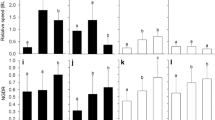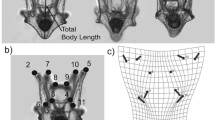Abstract
Explanation of the characteristics of the early developmental stage of organisms is an important problem in evolutionary biology. In studies to date, evolutionary biologists have proposed some theories that successfully explain egg size variation. Mesoscale water movements may transport early life stage organisms in the aquatic biosphere. We propose a novel biological view to explain the duration of the retention period at the spawning ground and egg size variations in aquatic organisms with a planktonic stage at least during the early part of their life history. We develop a life history model of the early life stage of such aquatic organisms that takes into account their adaptations to water currents and biotic environmental gradients in the currents. We hypothesize that the distance from the spawning grounds to the nursery grounds and the biological richness of the currents affect the adaptive life history design of these aquatic organisms, including adaptive retention time at the spawning ground and egg size. Various studies of fish biology describe in passing phenomena that suggest the validity of our deductions, but explicit empirical attempts to evaluate our predictions in the field of evolutional biology are needed.




Similar content being viewed by others
References
Bailey KM, Houde ED (1989) Predation on eggs and larvae of marine fishes and the recruitment problem. Adv Mar Biol 25:1–83
Bailey KM, Brown ES, Duffy-Anderson JT (2003) Aspects of distribution, transport and recruitment of Alaska plaice (Pleuronectes quadrituberculatus) in the Gulf of Alaska and eastern Bering Sea: comparison of marginal and central populations. J Sea Res 50:87–95
Bertram DF, Strathmann RR (1998) Effects of maternal and larval nutrition on growth and form of planktotrophic larvae. Ecology 79:315–327
Burgner RL (1991) Life history of sockeye salmon (Oncorhynchus nerka). In: Groot C, Margolis L (eds) Pacific salmon life history. UBC Press, Vancouver, pp 1–117
Buskey EJ, Coulter C, Strom S (1993) Locomotory patterns of microzooplankton—Potential effects on food selectivity of larval fish. Bull Mar Sci 53:29–43
Chambers RC, Leggett WC (1996) Maternal influences on variation in egg sizes in temperate marine fishes. Am Zool 36:180–196
Connell AD (2001) Pelagic eggs of marine fishes from Park Rynie, KwaZulu-Natal, South Africa: seasonal spawning patterns of the three most common species. Afr Zool 36:197–204
Coombs SH, Morgans D, Halliday NC (2001) Seasonal and ontogenetic changes in the vertical distribution of eggs and larvae of mackerel (Scomber scombrus L.) and horse mackerel (Trachurus trachurus L.). Fish Res 50:27–40
Cooperman M, Markle DF (2003) Rapid out-migration of lost river and shortnose sucker larvae from in-river spawning beds to in-lake rearing grounds. Trans Am Fish Soc 132:1138–1153
Cowan JH Jr, Houde ED (1993) Relative predation potentials of scyphomedusae, ctenophores and planktivorous fish on ichthyoplankton in Chesapeake Bay. Mar Ecol Prog Ser 95:55–65
Cushing DH (1975) Marine ecology and fisheries. Cambridge University Press, Cambridge
Duffy JT, Epifanio CE, Fuiman LA (1997) Mortality rates imposed by three scyphozoans on red drum (Sciaenops ocellatus Linnaeus) larvae in field enclosures. J Exp Mar Biol Ecol 212:123–131
Emlet RB, HoeghGuldberg O (1997) Effects of egg size on postlarval performance: experimental evidence from a sea urchin. Evolution 51:141–152
Fuiman LA, Batty RS (1994) Susceptibility of Atlantic herring and plaice larvae to predation by juvenile cod and herring at two constant temperatures. J Fish Biol 44:23–34
George SB (1999) Egg quality, larval growth and phenotypic plasticity in a forcipulate seastar. J Exp Mar Biol Ecol 237:203–224
Groot C, Marcolis L (1991) Pacific salmon: life histories. UBC Press, Vancouver
Hall JW, Smith TIJ, Lamprecht SD (1991) Movements and habitats of shortnose sturgeon, Acipenser brevirostrum in the Savannah River. Copeia, 695–702
Hare JA, Thorrold S, Walsh H, Reiss C, Valle-Levinson A, Jones C (2005) Biophysical mechanisms of larval fish ingress into Chesapeake Bay. Mar Ecol Prog Ser 303:295–310
Hart MW (1995) What are the costs of small egg size for a marine invertebrate with feeding planktonic larvae. Am Nat 146:415–426
Helfman GS, Collette BB, Facey DE (1997) The diversity of fishes. Blackwell Science
Hinckley S, Bailey KM, Picquelle SJ, Schumacher JD, Stabeno PJ (1991) Transport, distribution, and abundance of larval and juvenile walleye pollock (Theragra chalcogramma) in the western gulf of Alaska. Can J Fish Aquat Sci 48:91–98
Hinckley S, Hermann AJ, Mier KL, Megrey BA (2001) Importance of spawning location and timing to successful transport to nursery areas: a simulation study of Gulf of Alaska walleye pollock. ICES J Mar Sci 58:1042–1052
Hjort J (1914) Fluctuations in the great fisheries of northern Europe viewed in the light of biological research. Rapp P-V Reun Cons Int Explor Mer 20:1–228
Honma Y, Ozawa T, Chiba A (1980) Maturation and spawning behavior of the puffer, Fugu niphobles, occurring on the coast of Sado Island in the sea of Japan. Jpn J Ichthyol 27:129–138
Hunter JR (1972) Swimming and feeding behavior of larval anchovy Engraulis mordax. Fish Bull 70:821–838
Hutchings JA (1991) Fitness consequences of variation in egg size and good abundance in brook trout Salvelinus fontinalis. Evolution 45:1162–1168
Iguchi K, Yamaguchi M (1994) Adaptive significance of interpopulational and intrapopulational egg size variation in ayu Plecoglossus-altivelis (Osmeridae). Copeia, 184–190
Jones GP, Milicich MJ, Emslie MJ, Lunow C (1999) Self-recruitment in a coral reef fish population. Nature 402:802–804
Laurence GC, Rogers CA (1976) Effects of temperature and salinity on comparative embryo development and mortality of Atlantic cod (Gadus morhua L.) and haddock (Melanogrammus aeglefinus (L.)). J Conceil 36:220–228
Levitan DR (1993) The importance of sperm limitation to the evolution of egg size in marine-invertebrates. Am Nat 141:517–536
Levitan DR (1996) Effects of gamete traits on fertilization in the sea and the evolution of sexual dimorphism. Nature (London) 382:153–155
Levitan DR (2000) Optimal egg size in marine invertebrates: theory and phylogenetic analysis of the critical relationship between egg size and development time in echinoids. Am Nat 156:175–192
Marteinsdottir G, Gudmundsdottir A, Thorsteinsson V, Stefansson G (2000) Spatial variation in abundance, size composition and viable egg production of spawning cod (Gadus morhua L.) in Icelandic waters. ICES J Mar Sci 57:824–830
Miller TJ, Crowder LB, Rice JA, Marschall EA (1988) Larval size and recruitment mechanisms in fishes—toward a conceptual-framework. Can J Fish Aquat Sci 45:1657–1670
Minami T (1984) Early life history of flatfishes-III: characteristics of eggs (in Japanese with English abstract). Aquabiology 30:46–49
Moran AL (2004) Egg size evolution in tropical American arcid bivalves: the comparative method and the fossil record. Evolution 58:2718–2733
Norcross BL, Shaw RF (1984) Oceanic and estuarine transport of fish eggs and larvae: a review. Trans Am Fish Soc 113:153–165
Ochiai A, Tanaka M (1986) Ichthyology II. Kouseisha Kouseikaku (in Japanese)
Okiyama M (1990) Contrast in reproductive style between two species of sandfishes (Family Trichodontidae). Fish Bull USA 88:543–549
Okubo A, Levin SA (2001) Diffusion and ecological problems. 2nd edn. Springer, New York
Parrish RH, Nelson CS, Bakun A (1981) Transport mechanisms and reproductive success of fishes in the California current. Biol Oceanogr 1:175–203
Pepin P (1991) Effect of temperature and size on development, mortality, and survival rates of the pelagic early life-history stages of marine fish. Can J Fish Aquat Sci 48:503–518
Podolsky RD, Strathmann RR (1996) Evolution of egg size in free-spawners: consequences of the fertilization-fecundity trade-off. Am Nat 148:160–173
Robertson DR (1996) Egg size in relation to fertilization dynamics in free-spawning tropical reef fishes. Oecologia 108:95–104
Sherman K, Smith W, Morse W, Berman M, Green J, Ejsymont L (1984) Spawning strategies of fishes in relation to circulation, phytoplankton production, and pulses in zooplankton off the Northeastern United-States. Mar Ecol Prog Ser 18:1–19
Smith CC, Fretwell SD (1974) The optimal balance between size and number of offspring. Am Nat 108:499–507
Swearer SE, Caselle JE, Lea DW, Warner RR (1999) Larval retention and recruitment in an island population of a coral-reef fish. Nature 402:799–802
Vance RR (1973) On reproductive strategies in marine benthic invertebrates. Am Nat 107:339–352
Ware DM (1975) Relation between egg size, growth, and natural mortality of larval fish. J Fish Res Board Can 32:2503–2512
Winemiller KO, Rose KA (1993) Why do most fish produce so many tiny offspring? Am Nat 142:585–603
Author information
Authors and Affiliations
Corresponding author
Rights and permissions
About this article
Cite this article
Nishimura, K., Hoshino, N. The evolutionary pattern of early life history in water currents. Evol Ecol 23, 207–221 (2009). https://doi.org/10.1007/s10682-007-9213-5
Received:
Accepted:
Published:
Issue Date:
DOI: https://doi.org/10.1007/s10682-007-9213-5




